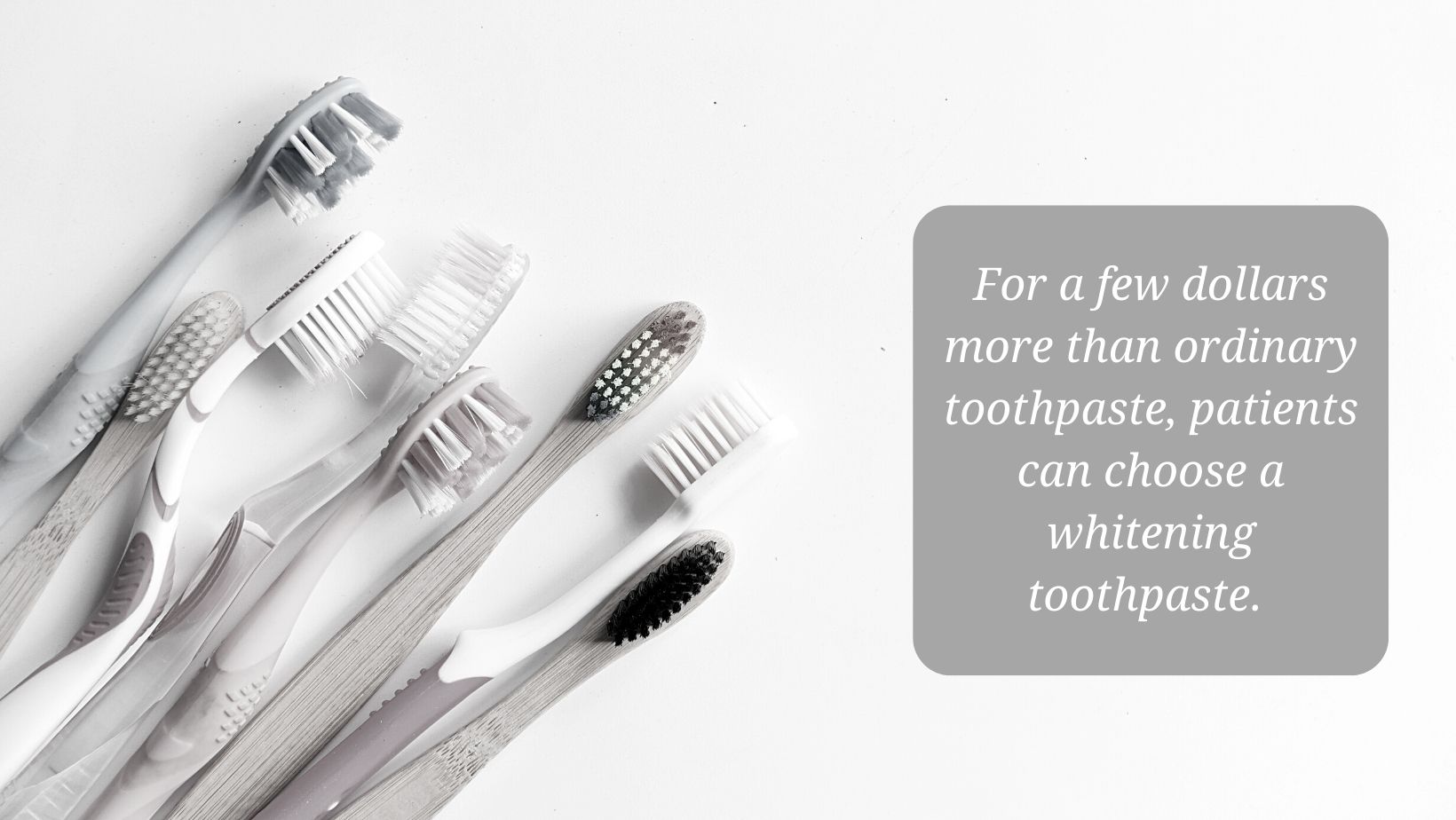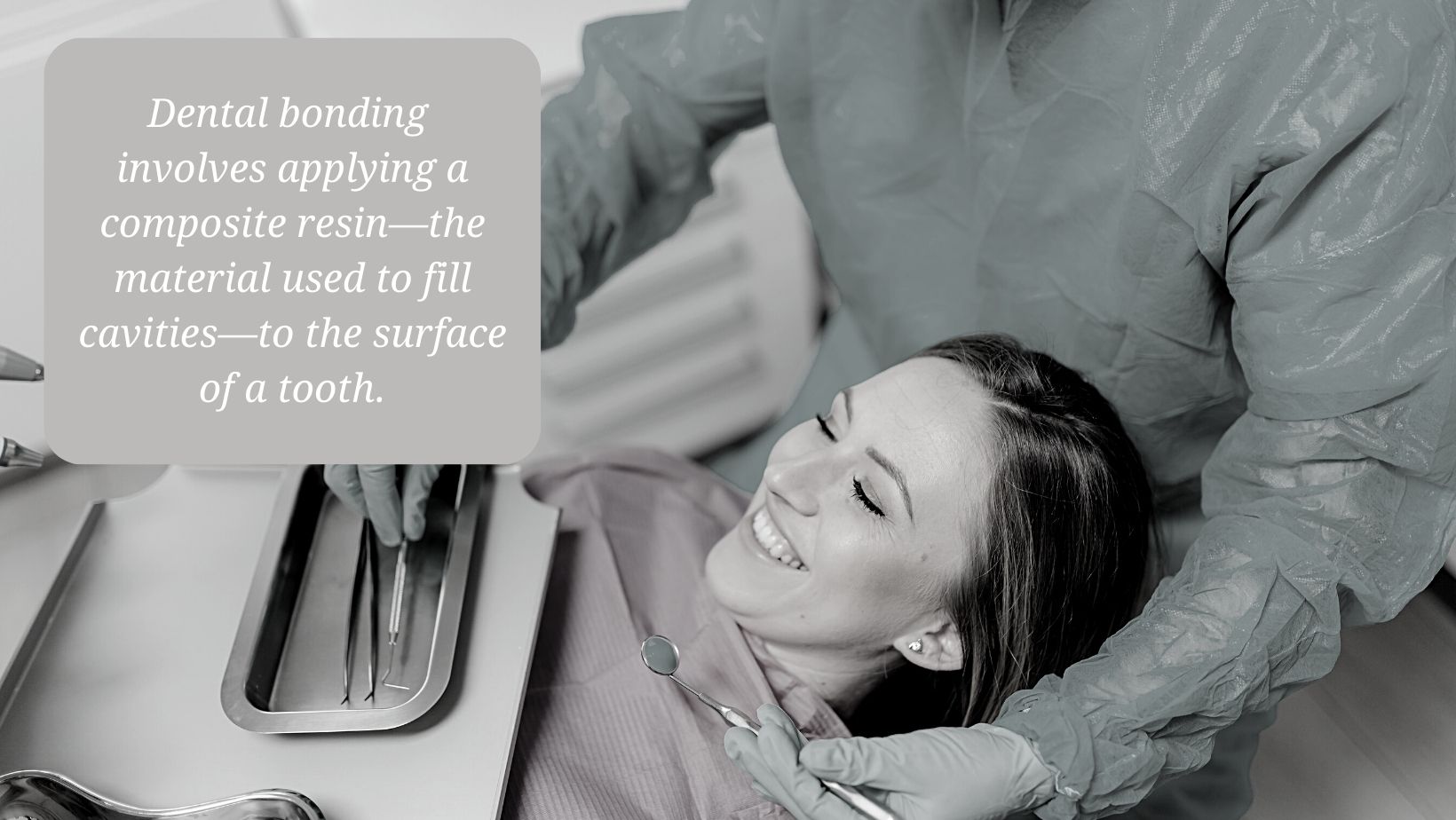Even someone with perfectly straight teeth might be unhappy with their smile. Tooth stains and discoloration can make them embarrassed to grin or show their teeth. Indeed, whiter teeth can boost self-confidence, and often give a healthier, more youthful appearance.
There are quite a few teeth whitening options for dull, dingy, discolored teeth. The choices range from inexpensive store-bought products to powerful cosmetic dentistry treatments.
The Right Solution for the Problem
It is a good idea to talk to a dentist before choosing a method to whiten teeth. They can give some professional insight into which products are likely to be successful. Their recommendations will vary based on each individual’s unique situation. Two factors that play significant roles in the treatment plan are the reason for the tooth discoloration and the type of staining.
Extrinsic stains come from sources outside the body, such as certain foods and beverages or smoking. If the teeth have nicotine stains or discoloration from drinking coffee or red wine, there is a good chance of whitening them with a number of different products.
Intrinsic staining has causes that include heredity, aging, and tooth decay. Unfortunately these stains are sometimes impossible to remove. Antibiotics, especially tetracycline, as well as other medicines, have been known to permanently change the color of teeth. While medications are an external source, their effects are intrinsic rather than a simple stain. Chemicals penetrate deep into the tooth, permanently changing its makeup and color.
Getting a dentist’s opinion about the source of tooth discoloration is an important first step. Knowing the treatment that is most likely to work (assuming that lightning the teeth is possible) can prevent wasting time and money on trial and error with several different products.
Which Teeth Whitening Choice is Right for You?
Very few people have unlimited time or money. With that in mind, we are listing the things one can do for whiter teeth in order from the most affordable and convenient, to the most expensive and invasive.
1. Whitening toothpaste
For a few dollars more than ordinary toothpaste, patients can choose a whitening toothpaste. Although many brands claim to whiten teeth, look for one with hydrogen peroxide. Hydrogen peroxide is a common teeth bleaching agent that can remove stains. Also, consider using an electric toothbrush. It will not make teeth whiter by itself, but it can do a better job at removing dingy-looking plaque from teeth.

2. Whitening strips and pens
For about $25 to $50 patients can buy strips or pens at the drugstore or online. Plastic strips coated with whitening gel or pens that can “paint on” bleaching agents are popular ways to tackle teeth whitening at home. Results vary greatly by brand, and if used incorrectly or overused, they could irritate gums and make teeth sensitive. It is best to see if any brand is on the Seal of Acceptance list compiled by the American Dental Association.
3. Whitening kits with LED light
Some kits use plastic trays that fit over the teeth and LED lights to help the whitening agents work. This type of kit was once only administered by dentists for patients to take home and use along with professional treatments in the office. Now, a number of brands are on the market for over-the-counter purchases. Like whitening strips, results vary from product to product, and success often depends on correct usage.
4. Professional teeth cleaning
Depending on the dental practice, a professional teeth cleaning typically averages around $125. This can be less with dental insurance, as coverage usually includes exams and cleanings twice a year. A good cleaning can remove some superficial surface stains like those caused by drinking coffee or smoking. Even though it is not considered a whitening treatment, for some this can be a low-cost solution for slightly brighter-looking teeth. Plus, it is a recommended part of good oral hygiene!
5. Professional whitening with ultraviolet light
Despite the availability of over-the-counter whitening products, the best results are often found at the dentist’s office. One big reason for this is that dental professionals are allowed to use higher concentrations of chemicals that lighten teeth. Store-bought products contain about 7% to 10% hydrogen peroxide. Dentists’ bleaching agents contain 25% to 35%. Since they are supervising the treatment, there is less chance of over-processing that can cause pain or an unnatural “too white” appearance. After applying the teeth bleaching agents, the dentist uses ultraviolet light to heat the solution, which speeds up the process and enhances the results. Treatment takes about 60 to 90 minutes and may require multiple visits. The cost averages about $$500.
6. Professional whitening with lasers
Dentists can use laser technology instead of ultraviolet light for teeth whitening. The chemicals and the procedure are the same, but a laser heats the bleaching agent. The main difference is that the dentist must direct the tiny beam over each tooth individually, whereas a light heats the entire arch of teeth at once. Results are similar to UV light but tend to happen faster. The process is also more expensive, averaging between $600 and $800.
7. Tooth bonding
Dental bonding is not usually used for teeth whitening, but it might solve some cases. It involves applying a composite resin—the material used to fill cavities—to the surface of a tooth. Because the composite is tinted to match the color of the tooth, it can be used to cover small problematic imperfections or permanent stains.

8. Veneers
Like bonding, there are purposes that are more common for veneers than teeth whitening. Veneers are thin pieces of composite or porcelain that completely cover the front of a tooth the way a fake nail covers a fingernail. For permanent stains that will not respond to other teeth whitening treatments, this could be a solution—although it is a costly and invasive one. Veneers can cost about $925 to $2500 per tooth—or $10,000 to $40,000 for a full set. They also require the removal of some of the tooth’s enamel in order to be attached. The results, however, can go beyond teeth whitening, covering up other imperfections of size and shape, leaving the patient with a perfect smile.
Looking for the Best Value for Teeth Whitening
Teeth whitening is a cosmetic procedure and does not impact the patient’s dental health. For this reason, it is not typically covered by dental insurance. So, while it is important to find a solution that works, it must also fit the patient’s budget for out-of-pocket expenses.
As the above list illustrates, there are many inexpensive drug store products on the market. But their effectiveness varies greatly and is not guaranteed. Professional teeth whitening at the dentist might get better results, but it is pricier with treatment costing several hundred or even a thousand dollars.
Patients must weigh their options carefully to find the solution with the best value. That means something that works well, is convenient, shows fast results, lasts a reasonable amount of time, and fits their budget.
Avoiding Future Tooth Stains
Once a patient finds a solution that works to whiten their teeth, they will want to keep them that way. The advice for keeping teeth white after treatment is the same as for anyone who wants to avoid staining in the first place.
- Avoid food and drink that is likely to stain teeth such as coffee, red wine, dark soda, etc.
- Avoid tobacco products and nicotine including cigarettes, chewing tobacco, and vaping.
- Practice good oral hygiene: Brush and floss at least twice a day.
- Visit the dentist twice a year for a dental exam and professional cleaning.
If whiter teeth are something you are considering, start by consulting with your dentist. They will help determine what will work best for your situation. If you need to find a dental practice in your area, our online search tool can help.


